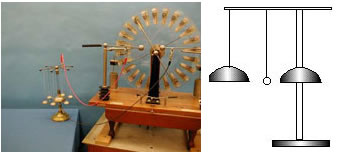Demos: 5A-10 Motion in an Electric Field

This a set of demonstrations related to effects resulting from electric field forces.
(a) A ping pong ball is free to roll inside a horizontally mounted glass tube mounted between the terminals of the small Wimshurst machine. When the machine is in operation, the ball moves back and forth in the tube as it first receives a charge from one terminal and then is repelled to the other terminal, where it is charged oppositely.
(b) A set of electric “chimes,” consisting of four bells suspended from conducting threads, and a central bell affixed to an insulating stand. A small ball is suspended from an insulating thread so it hangs between the two bells. The central bell is grounded (or attached to the opposite terminal), whereas the other four bells are are charged from a small Wimshurst machine. The hanging ball is attracted to the hanging bell by charge induction, causing the ball to strike the bell. The ball then picks up up the charge of the bell and is repelled, causing it to strike the central (grounded) bell. The ball is discharged and the process begins all over again.
Directions: (For details of the setups, see the lab-demo technician.)
(a) Release the post so that the horizontal glass tube can be moved upward, in line with the knobs on the Wimshurst machine. Place the knobs inside the ends of the tube. (Be sure the ping pong ball is inside the tube.) Turn the crank on the machine and after several seconds the ball should begin to oscillate back and forth in the tube.
(b) The chimes are often temperamental, but by giving the system a “jump start,” it should work quite nicely. Place the lead from one terminal on the post connector. Connect the top knob either to ground or to the other terminal of the machine. (Which works best is a matter of trial and error.) After several cranks of the machine, the bells should begin ringing.
Suggestions for Presentation: One suggestion is introduce a new kind of “doorbell” system! Explain how the system is put together and what should happen. Or better: Describe the connections and let the students discuss what might transpire. Because of the hanging bells and the suspended balls, they are sure to guess the system will ring, but how can it happen? What is the role of each of the electrical connections?
Applications:
Last Updated: Nov 30, 2023 11:25 AM